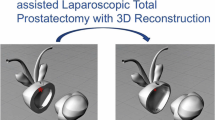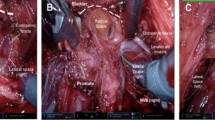Abstract
Objective
To evaluate the relationship between enlarged prostate, bulky median lobe (BML) or prior benign prostatic hyperplasia (BPH) surgery and perioperative functional, and oncological outcomes in high-risk (HR) prostate cancer (PCa) patients treated with Retzius-sparing robot-assisted radical prostatectomy (RS-RARP).
Methods
320 HR-PCa patients treated with RS-RARP between 2011 and 2020 at a single high-volume center. The relationship between prostate volume, BML, prior BPH surgery and perioperative outcomes, Clavien–Dindo (CD) grade ≥ 2 90-day postoperative complications, positive surgical margins (PSMs), and urinary continence (UC) recovery was evaluated respectively in multivariable linear, logistic and Cox regression models. Complications were collected according to the standardized methodology proposed by EAU guidelines. UC recovery was defined as the use of zero or one safety pad.
Results
Overall, 5.9% and 5.6% had respectively a BML or prior BPH surgery. Median PV was 45 g (range: 14–300). The rate of focal and non-focal PSMs was 8.4% and 17.8%. 53% and 10.9% patients had immediate UC recovery and CD ≥ 2. The 1- and 2-yr UC recovery was 84 and 85%. PV (p = 0.03) and prior BPH surgery (p = 0.02) was associated with longer operative time. BML was independent predictor of time to bladder catheter removal (p = 0.001). PV was independent predictor of PSMs (OR: 1.02; p = 0.009). Prior BPH surgery was associated with lower UC recovery (HR: 0.5; p = 0.03).
Conclusion
HR-PCa patients with enlarged prostate have higher risk of PSMs, while patients with prior BPH surgery have suboptimal UC recovery. These findings should help physicians for accurate preoperative counseling and to improve surgical planning in case of HR-PCa patients with challenging features.
Similar content being viewed by others
References
Mottet N, van den Bergh RCN, Briers E et al (2021) EAU-EANM-ESTRO-ESUR-SIOG guidelines on prostate cancer—2020 update. Part 1: Screening, diagnosis, and local treatment with curative intent. Eur Urol. https://doi.org/10.1016/j.eururo.2020.09.042
Galfano A, Ascione A, Grimaldi S et al (2010) A new anatomic approach for robot-assisted laparoscopic prostatectomy: a feasibility study for completely intrafascial surgery. Eur Urol. https://doi.org/10.1016/j.eururo.2010.06.008
Phukan C, Mclean A, Nambiar A et al (2020) Retzius sparing robotic assisted radical prostatectomy vs conventional robotic assisted radical prostatectomy: a systematic review and meta-analysis. World J Urol. https://doi.org/10.1007/s00345-019-02798-4
Checcucci E, Veccia A, Fiori C et al (2020) Retzius-sparing robot-assisted radical prostatectomy vs the standard approach: a systematic review and analysis of comparative outcomes. BJU Int. https://doi.org/10.1111/bju.14887
Rosenberg JE, Jung JH, Edgerton Z et al (2020) Retzius-sparing versus standard robotic-assisted laparoscopic prostatectomy for the treatment of clinically localized prostate cancer. Cochrane Database Syst Rev. https://doi.org/10.1002/14651858.CD013641.pub2
Dell’Oglio P, Tappero S, Longoni M et al (2022) Retzius-sparing robot-assisted radical prostatectomy in high-risk prostate cancer patients: results from a large single-institution series. Eur Urol Open Sci 38:69–78. https://doi.org/10.1016/j.euros.2022.02.007
Galfano A, Panarello D, Secco S, et al (2018) Does prostate volume have an impact on the functional and oncological results of Retzius-sparing robot-assisted radical prostatectomy? Minerva Urologica e Nefrologica https://doi.org/10.23736/S0393-2249.18.03069-2
Qian J, Fu Y, Wu X, et al (2021) Impact of protruded median lobe on perioperative, urinary continence and oncological outcomes of Retzius-sparing robot- assisted radical prostatectomy. Transl Androl Urol 10:538–547. https://doi.org/10.21037/tau-20-1229
Kim LHC, Santok GD, Raheem AA et al (2018) Retzius-sparing robot-assisted radical prostatectomy is safe for patients with prior transurethral prostate surgery. Int Braz J Urol 44:842–843. https://doi.org/10.1590/s1677-5538.ibju.2017.0316
Stonier T, Simson N, Davis J, Challacombe B (2019) Retzius-sparing robot-assisted radical prostatectomy (RS-RARP) vs standard RARP: it’s time for critical appraisal. BJU Int 123:5–7. https://doi.org/10.1111/bju.14468
D’Amico AV (1998) Biochemical outcome after radical prostatectomy, external beam radiation therapy, or interstitial radiation therapy for clinically localized prostate cancer. JAMA. https://doi.org/10.1001/jama.280.11.969
Jeong CW, Lee S, Oh JJ et al (2014) Quantification of median lobe protrusion and its impact on the base surgical margin status during robot-assisted laparoscopic prostatectomy. World J Urol 32:419–423. https://doi.org/10.1007/S00345-013-1118-Z
Clavien PA, Barkun J, de Oliveira ML et al (2009) The Clavien-dindo classification of surgical complications. Ann Surg. https://doi.org/10.1097/SLA.0b013e3181b13ca2
Mitropoulos D, Artibani W, Graefen M et al (2012) Reporting and grading of complications after urologic surgical procedures: an ad hoc eau guidelines panel assessment and recommendations. Eur Urol. https://doi.org/10.1016/j.eururo.2011.10.033
Mazzone E, D’Hondt F, Beato S et al (2021) Robot-assisted radical cystectomy with intracorporeal urinary diversion decreases postoperative complications only in highly comorbid patients: findings that rely on a standardized methodology recommended by the European Association of Urology Guidelines. World J Urol. https://doi.org/10.1007/s00345-020-03237-5
Gandaglia G, Bravi CA, Dell’Oglio P et al (2018) The impact of implementation of the european association of urology guidelines panel recommendations on reporting and grading complications on perioperative outcomes after robot-assisted radical prostatectomy. Eur Urol. https://doi.org/10.1016/j.eururo.2018.02.025
Dell’Oglio P, Andras I, Ortega D et al (2021) Impact of the implementation of the EAU guidelines recommendation on reporting and grading of complications in patients undergoing robot-assisted radical cystectomy: a systematic review. Eur Urol. https://doi.org/10.1016/j.eururo.2021.04.030
Cacciamani GE, Maas M, Nassiri N et al (2021) Impact of pelvic lymph node dissection and its extent on perioperative morbidity in patients undergoing radical prostatectomy for prostate cancer: a comprehensive systematic review and meta-analysis. Eur Urol Oncol. https://doi.org/10.1016/j.euo.2021.02.001
Vickers AJ, Savage CJ, Hruza M et al (2009) The surgical learning curve for laparoscopic radical prostatectomy: a retrospective cohort study. Lancet Oncol 10:475–480. https://doi.org/10.1016/S1470-2045(09)70079-8
Dell’Oglio P, Mazzone E, Lambert E et al (2021) The effect of surgical experience on perioperative and oncological outcomes after robot-assisted radical cystectomy with intracorporeal urinary diversion: evidence from a referral centre with extensive experience in robotic surgery. Eur Urol Focus 7:352–358. https://doi.org/10.1016/j.euf.2020.01.016
Sayyid RK, Simpson WG, Lu C et al (2017) Retzius-sparing robotic-assisted laparoscopic radical prostatectomy: a safe surgical technique with superior continence outcomes. J Endourol. https://doi.org/10.1089/end.2017.0490
Dalela D, Jeong W, Prasad M-A et al (2017) A pragmatic randomized controlled trial examining the impact of the Retzius-sparing approach on early urinary continence recovery after robot-assisted radical prostatectomy. Eur Urol. https://doi.org/10.1016/j.eururo.2017.04.029
Li-Wen Chang, Sheng-Chun Hung, Ju-Chuan Hu, Kun-Yuan Chiu (2018) Retzius-sparing robotic-assisted radical prostatectomy associated with less bladder neck descent and better early continence outcome. Anticancer Res https://doi.org/10.21873/anticanres.12228
Asimakopoulos AD, Topazio L, de Angelis M et al (2019) Retzius-sparing versus standard robot-assisted radical prostatectomy: a prospective randomized comparison on immediate continence rates. Surg Endosc. https://doi.org/10.1007/s00464-018-6499-z
Lim SK, Kim KH, Shin T-Y et al (2014) Retzius-sparing robot-assisted laparoscopic radical prostatectomy: combining the best of retropubic and perineal approaches. BJU Int. https://doi.org/10.1111/bju.12705
Egan J, Marhamati S, Carvalho FLF et al (2021) Retzius-sparing robot-assisted radical prostatectomy leads to durable improvement in urinary function and quality of life versus standard robot-assisted radical prostatectomy without compromise on oncologic efficacy: single-surgeon series and step-by-step guide. Eur Urol 79:839–857. https://doi.org/10.1016/j.eururo.2020.05.010
Menon M, Dalela D, Jamil M et al (2018) Functional recovery, oncologic outcomes and postoperative complications after robot-assisted radical prostatectomy: an evidence-based analysis comparing the retzius sparing and standard approaches. J Urol 199:1210–1217. https://doi.org/10.1016/j.juro.2017.11.115
Umari P, Eden C, Cahill D et al (2021) Retzius-sparing versus standard robot-assisted radical prostatectomy: a comparative prospective study of nearly 500 patients. J Urol. https://doi.org/10.1097/JU.0000000000001435
Tai T-E, Wu C-C, Kang Y-N, Wu J-C (2020) Effects of Retzius sparing on robot-assisted laparoscopic prostatectomy: a systematic review with meta-analysis. Surg Endosc. https://doi.org/10.1007/s00464-019-07190-2
Galfano A, Secco S, Dell’Oglio P et al (2021) Retzius-sparing robot-assisted radical prostatectomy: early learning curve experience in three continents. BJU Int 127:412–417. https://doi.org/10.1111/bju.15196
Abdollah F, Dalela D, Sood A et al (2016) Intermediate-term cancer control outcomes in prostate cancer patients treated with robotic-assisted laparoscopic radical prostatectomy: a multi-institutional analysis. World J Urol. https://doi.org/10.1007/s00345-016-1781-y
Kumar A, Samavedi S, Bates AS et al (2017) Safety of selective nerve sparing in high risk prostate cancer during robot-assisted radical prostatectomy. J Robot Surg. https://doi.org/10.1007/s11701-016-0627-3
Porpiglia F, Checcucci E, Amparore D et al (2019) Augmented-reality robot-assisted radical prostatectomy using hyper-accuracy three-dimensional reconstruction (HA3D™) technology: a radiological and pathological study. BJU Int 123:834–845. https://doi.org/10.1111/bju.14549
Funding
The research was conducted in the absence of any commercial or financial relationships that could be construed as a potential conflict of interest. This research received no specific grant from any funding agency in the public, commercial, or not-for-profit sectors.
Author information
Authors and Affiliations
Contributions
Tappero: Project development, Data analysis, Manuscript writing. Dell’Oglio: Project development, Data analysis, Manuscript writing. Longoni: Data collection, Data analysis. Buratto: Data collection. Palagonia: Data collection, Data analysis. Scilipoti: Data collection. Vecchio: Data collection. Martiriggiano: Data collection. Secco: Project development, Data analysis. Olivero: Project development, Data analysis. Barbieri: Data collection. Napoli: Data collection. Strada: Data collection. Petralia: Critical revision of the manuscript, Important intellectual content. Di Trapani: Critical revision of the manuscript, Important intellectual content. Bocciardi: Project development, Critical revision of the manuscript, Important intellectual content, Supervision. Galfano: Project development, Manuscript writing, Supervision.
Corresponding author
Ethics declarations
Conflict of interest
The authors declare that there is no conflict of interests.
Ethics consent statement
Due to the anonymously coded design of the employed database, study-specific Institutional Review Board ethics approval was not required.
Patient consent statement, permission to reproduce material from other sources and clinical trial registration
Not applicable.
Additional information
Publisher's Note
Springer Nature remains neutral with regard to jurisdictional claims in published maps and institutional affiliations.
Supplementary Information
Below is the link to the electronic supplementary material.
Rights and permissions
About this article
Cite this article
Tappero, S., Dell’Oglio, P., Longoni, M. et al. Challenging cases in high-risk prostate cancer patients treated with Retzius-sparing robot-assisted radical prostatectomy. World J Urol 40, 1993–1999 (2022). https://doi.org/10.1007/s00345-022-04073-5
Received:
Accepted:
Published:
Issue Date:
DOI: https://doi.org/10.1007/s00345-022-04073-5




